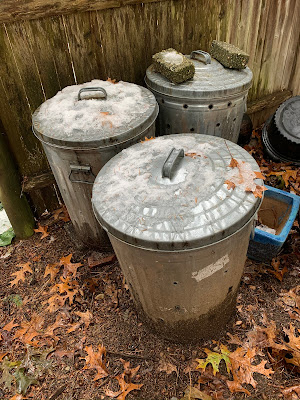This week my garden club got together on Zoom to watch a video of a talk by Doug Tallamy. I’ve been a Tallamy follower since 2011, when his book Bringing Nature Home changed my gardening philosophy. Since then I’ve been working on growing more native plants.
 |
| Insectary bed: flowers and foliage for pollinators and other insects |
In 2019 Tallamy published a new, more prescriptive book, Nature’s Best Hope. He’s marshaling us to rescue biodiversity by creating Homegrown National Park, a combined nationwide habitat for native insects in our backyards.
Tallamy demonstrates how we can get the most environmental bang from our native plantings by prioritizing caterpillar host plants. Caterpillars provide the lion’s share of the biomass birds need to feed their young.
 |
| Hummingbirds feeding insects to their chick |
Tallamy has identified more than 800 caterpillar species on his 10-acre property in Pennsylvania as he and his wife have replaced nonnative invasive plants with natives (check out his stunning photos of some of them in the new book).
A light bulb went on for me when Tallamy mentioned that people occasionally write him to point out that an imported species—the Asian ginkgo tree (Ginkgo biloba), for example--used to be native to North America in a previous geological era and claim it’s therefore entitled to native plant status. That doesn’t matter, he said. What’s important is whether a plant supports any native insects. Ginkgoes don’t.
 |
| Ginkgo is a beautiful tree from Asia-photo Sunroofguy |
We’ve come a long way since concern about supporting insects first surfaced. I remember reading in the 1980s about designing a butterfly garden. That was when we planted butterfly bush (Buddleia spp.), which is now out of favor because it’s nonnative and potentially invasive. Butterfly bush and many other flowering imports do serve a purpose, though, providing nectar for bees, butterflies and moths in their adult forms.
 |
| Eastern Tiger swallowtail nectaring on a butterfly bush |
As I became more aware of my garden as an ecosystem, I started planting native flowers that provide the right pollen for native pollinators, especially bees. Now we can take the next step and choose to plant for native caterpillars. These aren’t looking for flowers. While adult pollinators can afford to sip nectar unselectively, caterpillars need to eat the right leaves to be able to grow and pupate.
Because of decades of research in this area, we now know that about 90 percent of insects specialize: they’ve evolved to live off a limited group of plants. Most caterpillars aren’t equipped to deal with the chemical defenses mounted by plant species outside their small group of native host plants.
 |
| Monarch caterpillars need to eat milkweed |
So with data accumulating about which plants host which native insects, we can stop fighting about whether gardeners should plant only native plants. Instead, we can ask which plants host the most insects. Tallamy proposes that we prioritize keystone plants, such as native oaks, willows, cherries, and goldenrods, that provide food for hundreds of species of native caterpillars. How to find these? You can go to the websites of the National Wildlife Federation and the Audubon Society and get lists for your zip code. Somehow this prescription seems much more doable.
 |
| Native red oak supports more insects than any other local tree-photo Jason Hollinger |






